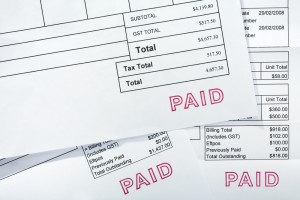 As of next February, I’ll have been freelancing for five years. During that time I’ve had clients who paid me within the hour I sent the invoice, a couple of coldhearted clients who never paid at all, and – just recently – one client who paid me 10 months after I sent the invoice. (Yes, it really happens!)
As of next February, I’ll have been freelancing for five years. During that time I’ve had clients who paid me within the hour I sent the invoice, a couple of coldhearted clients who never paid at all, and – just recently – one client who paid me 10 months after I sent the invoice. (Yes, it really happens!)
Most clients pay within 30 days or so, but sometimes there’s a holdup. Once in a while, especially when I first got started, the holdup was my fault. After all, I never went to invoice writing school. My first invoices came from a template I found in Microsoft Word.
Throughout the years I’ve changed my invoicing strategy to make sure my clients have all the info they need and the means to pay me fast. Here’s my strategy. What’s yours?
1.) Ask Your Clients
Have you thought about what your clients want? You do this for everything else with your business, but when it comes to invoices you seem to think one size fits all. Why not ask what your clients really want? You may be surprised what the answers are – for example, the super tech savvy client may actually want a small invoice in the mail because he likes the paper trail. You never know until you ask! What you definitely don’t want is to be that one squeaky wheel who invoices in an odd way. Because then your client may put off paying your invoice until the last minute.
2.) Include Your Payment Terms
Many clients outsource payroll or have an assistant who handles their billing. Keep in mind that the client who hired you probably isn’t the one who pays the bills. They don’t know that you charge a 5% late fee if the invoice isn’t paid within 30 days. Including these little details on your invoices will prevent you from landing in the “do it later” pile.
3.) Use Online Invoicing
We’re creative, entrepreneurial, and big thinkers. For us, it can be easy to let little details like that $250 invoice for a one-off project fall through the cracks. Using an online invoicing program is just the thing for the creative entrepreneur. They generally have an organized dashboard so that you can see at-a-glance what client owes you how much. Plus…
4.) Accept Payments Online
Wouldn’t you rather send a client an invoice and see it in your account within the hour rather than wait on a pesky paper check that you have to schlep over to the bank? This is not usually an issue for Under 30 CEO’s. In fact, it’s more common with experienced freelancers who got started before online payments were prevalent, or freelancers who are accustomed to working with large companies who cut large batches of accounts payable checks. Still, if you’re still emailing Microsoft Word templates, or – gasp! – mailing paper invoices, now’s the time to update to online invoicing.
We all started businesses because we had an idea or a special skill that customers were willing to pay for. None of us went to invoice writing school. So reevaluate your invoices based on these bullet points so that you can get back to doing what you do best – running your business.
This guest post is brought to you by WePay, the easiest way to manage invoices and accept payments online. Sign up today for a free account!
Image Credit: Shutterstock.com



